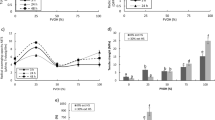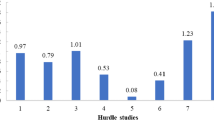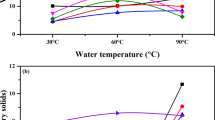Abstract
The aim of this work was to evaluate the degradation kinetics and stability of micro wet milled orange juice powders obtained by vacuum spray drying, using maltodextrin as a carrier agent. Powders were produced with four combinations of orange juice solids/maltodextrin solids 60:40, 50:50, 40:60, and 30:70 by weight. Ascorbic acid degradation, color, and antioxidant activity of powders were evaluated throughout 90 days. Powders were stored at 10, 25, and 35 °C and relative humidity of 33%. Temperature and storage time negatively influenced the stability of ascorbic acid and color, whereas antioxidant activity increased at the beginning of storage at a higher temperature then decreased slightly after 60 days. For stability study, powders were stored at different water activities (0.11 to 0.84) in order to determine the plasticizing effects of water on glass transition temperature. Both water activity and glass transition temperature were used to predict the critical conditions for storage. Vacuum spray dried powder produced with a ratio of 30:70 (orange juice solids/maltodextrin solids) was considered as the most stable, since it showed highest critical water activity (aw = 0.61) and lowest moisture content (0.11 g water/g of dry solid) among the four powders. Vacuum spray drying using superheated steam as the heating medium was proven to be an effective way of producing orange juice powders with minimum loss of nutrients.




Similar content being viewed by others
References
Alvarado, J. D., & Palacios Viteri, N. (1989). Effect of temperature on the aerobic degradation of vitamin C in citric fruit juices. Archivos Latinoamericanos de Nutrición, 39(4), 601–612.
Angel, R. C. M., Espinosa-Muñoz, L. C., Aviles-Aviles, C., González-García, R., Moscosa-Santillán, M., Grajales-Lagunes, A., & Abud-Archila, M. (2009). Spray-drying of passion fruit juice using lactose-maltodextrin blends as the support material. Brazilian Archives of Biology and Technology, 52(4), 1011–1018. doi:10.1590/S1516-89132009000400026.
Arabhosseini, A., Huisman, W., van Boxtel, A., & Müller, J. (2005). Modeling of the equilibrium moisture content (EMC) of tarragon (Artemisia dracunculus L.). International Journal of Food Engineering, 1(5). doi:10.2202/1556-3758.1025.
Bizot, H. (1983). Using the GAB model to construct sorption isotherms. In: Jowitt, R., Escher, F.,Hallstrom, B.M., Spiess, W.E., Vos, G. (Eds.). Physical properties of foods, (pp. 43-54). London: Applied Science Publisher.
Burdurlu, H. S., Koca, N., & Karadeniz, F. (2006). Degradation of vitamin C in citrus juice concentrates during storage. Journal of Food Engineering, 74(2), 211–216. doi:10.1016/j.jfoodeng.2005.03.026.
Caparino, O. A., Sablani, S. S., Tang, J., Syamaladevi, R. M., & Nindo, C. I. (2013). Water sorption, glass transition, and microstructures of refractance window- and freeze-dried mango (Philippine “Carabao” Var.) powder. Drying Technology, 31(16), 1969–1978. doi:10.1080/07373937.2013.805143.
Ferrari, C. C., Marconi Germer, S. P., Alvim, I. D., & de Aguirre, J. M. (2013). Storage stability of spray-dried blackberry powder produced with maltodextrin or gum Arabic. Drying Technology, 31(4), 470–478. doi:10.1080/07373937.2012.742103.
Gibbs, B. F., Kermasha, S., Alli, I., & Mulligan, C. N. (1999). Encapsulation in the food industry: a review. International Journal of Food Sciences and Nutrition, 50(3), 213–224 http://www.ncbi.nlm.nih.gov/pubmed/10627837. Accessed 17 November 2016.
Gordon, M., & Taylor, J. S. (1952). Ideal copolymers and the second-order transitions of synthetic rubbers. I. Non-crystalline copolymers. Journal of Applied Chemistry, 2(9), 493–500. doi:10.1002/jctb.5010020901.
Goula, A. M., & Adamopoulos, K. G. (2010). A new technique for spray drying orange juice concentrate. Innovative Food Science & Emerging Technologies, 11(2), 342–351. doi:10.1016/j.ifset.2009.12.001.
Goula, A. M., Karapantsios, T. D., Achilias, D. S., & Adamopoulos, K. G. (2008). Water sorption isotherms and glass transition temperature of spray dried tomato pulp. Journal of Food Engineering, 85(1), 73–83. doi:10.1016/j.jfoodeng.2007.07.015.
Gvozdenović, J., Popov-Raljić, J., & Curaković, M. (2000). Investigation of characteristic colour stability of powdered orange. Food Chemistry, 70(3), 291–301. doi:10.1016/S0308-8146(00)00060-1.
Ibrahim Silva, P., Stringheta, P. C., Teof’ilo, R. F., & De Oliveira, I. R. N. (2013). Parameter optimization for spray-drying microencapsulation of jaboticaba (Myrciaria jaboticaba) peel extracts using simultaneous analysis of responses. Journal of Food Engineering, 117(4), 538–544. doi:10.1016/j.jfoodeng.2012.08.039.
Islam, M. Z., Kitamura, Y., Yamano, Y., & Kitamura, M. (2016). Effect of vacuum spray drying on the physicochemical properties, water sorption and glass transition phenomenon of orange juice powder. Journal of Food Engineering, 169, 131–140. doi:10.1016/j.jfoodeng.2015.08.024.
Karel, M. (1975). Freeze dehydration of foods. In D. B. Karel, M., Fennema, O.R., Lund (Ed.). In Principles of food science (pp. 359–395). New York: Marcel Dekker, Inc..
Kha, T. C., Nguyen, M. H., & Roach, P. D. (2010). Effects of spray drying conditions on the physicochemical and antioxidant properties of the Gac (Momordica cochinchinensis) fruit aril powder. Journal of Food Engineering, 98(3), 385–392. doi:10.1016/j.jfoodeng.2010.01.016.
Khalloufi, S., El-Maslouhi, Y., & Ratti, C. (2000a). Mathematical model for prediction of glass transition temperature of fruit powders. Journal of Food Science, 65(5), 842–848. doi:10.1111/j.1365-2621.2000.tb13598.x.
Koyama, M., & Kitamura, Y. (2014). Development of a new rice beverage by improving the physical stability of rice slurry. Journal of Food Engineering, 131, 89–95. doi:10.1016/j.jfoodeng.2014.01.030.
Kurowska, E. M., Spence, J. D., Jordan, J., Wetmore, S., Freeman, D. J., Piché, L. A., & Serratore, P. (2000). HDL-cholesterol-raising effect of orange juice in subjects with hypercholesterolemia. The American Journal of Clinical Nutrition, 72(5), 1095–1100 http://www.ncbi.nlm.nih.gov/pubmed/11063434. Accessed 12 Aug. 2016.
Lee, H. S., & Coates, G. A. (1999). Vitamin C in frozen, fresh squeezed, unpasteurized, polyethylene-bottled orange juice: a storage study. Food Chemistry, 65(2), 165–168. doi:10.1016/S0308-8146(98)00180-0.
Lloyd, R. J., Dong Chen, X., & Hargreaves, J. B. (1996). Glass transition and caking of spray-dried lactose. International Journal of Food Science & Technology, 31(4), 305–311. doi:10.1046/j.1365-2621.1996.00352.x.
Mishra, P., Mishra, S., & Mahanta, C. L. (2014). Effect of maltodextrin concentration and inlet temperature during spray drying on physicochemical and antioxidant properties of amla (Emblica officinalis) juice powder. Food and Bioproducts Processing, 92(3), 252–258. doi:10.1016/j.fbp.2013.08.003.
Moraga, G., Igual, M., García-Martínez, E., Mosquera, L. H., & Martínez-Navarrete, N. (2012). Effect of relative humidity and storage time on the bioactive compounds and functional properties of grapefruit powder. Journal of Food Engineering, 112(3), 191–199. doi:10.1016/j.jfoodeng.2012.04.002.
Nicoli, M. C., Anese, M., Parpinel, M. T., Franceschi, S., & Lerici, C. R. (1997). Loss and/or formation of antioxidants during food processing and storage. Cancer Letters, 114(1–2), 71–74. doi:10.1016/S0304-3835(97)04628-4.
Ostrowska-Ligęza, E., Jakubczyk, E., Górska, A., Wirkowska, M., & Bryś, J. (2014). The use of moisture sorption isotherms and glass transition temperature to assess the stability of powdered baby formulas. Journal of Thermal Analysis and Calorimetry, 118(2), 911–918. doi:10.1007/s10973-014-3846-8.
Peleg, M. (1996). On modeling changes in food and biosolids at and around their glass transition temperature range. Critical Reviews in Food Science and Nutrition, 36(1–2), 49–67. doi:10.1080/10408399609527759.
Polydera, A. C., Stoforos, N. G., & Taoukis, P. S. (2003). Comparative shelf life study and vitamin C loss kinetics in pasteurised and high pressure processed reconstituted orange juice. Journal of Food Engineering, 60(1), 21–29. doi:10.1016/S0260-8774(03)00006-2.
Quek, S. Y., Chok, N. K., & Swedlund, P. (2007). The physicochemical properties of spray-dried watermelon powders. Chemical Engineering and Processing: Process Intensification, 46(5), 386–392. doi:10.1016/j.cep.2006.06.020.
Quirijns, E. J., van Boxtel, A. J., van Loon, W. K., & van Straten, G. (2005). Sorption isotherms, GAB parameters and isosteric heat of sorption. Journal of the Science of Food and Agriculture, 85(11), 1805–1814. doi:10.1002/jsfa.2140.
Rahman, M. S. (2006). State diagram of foods: its potential use in food processing and product stability. Trends in Food Science and Technology, 17(3), 129–141. doi:10.1016/j.tifs.2005.09.009.
Rahman, & Labuza, T. P. (1999). Water activty and food preservation. In handbook of food preservation(E. Rahman, M.S, Ed.). New York: Marcel Dekker.
Righetto, A. M., & Netto, F. M. (2006). Vitamin C stability in encapsulated green west Indian cherry juice and in encapsulated synthetic ascorbic acid. Journal of the Science of Food and Agriculture, 86(8), 1202–1208. doi:10.1002/jsfa.2469.
Rockland. (1987). Water activity: theory and applications to food. CRC Press.
Romero Rodriguez, M. A., Vazquez Oderiz, M. L., Lopez Hernandez, J., & Simal Lozano, J. (1992). Determination of vitamin c and organic acids in various fruits by hplc. Journal of Chromatographic Science, 30(11), 433–437. doi:10.1093/chromsci/30.11.433.
Roos, Y. H. (1995). Water activity and glass transition temperature. In J. W.-C. G. V. Barbosa-Canovas (Ed.), Food preservation by moisture control—fundamentals and applications (pp. 133–154). Lancaster: Technomic Publishing Company Inc..
Sablani, S. S., Kasapis, S., & Rahman, M. S. (2007). Evaluating water activity and glass transition concepts for food stability. Journal of Food Engineering, 78(1), 266–271. doi:10.1016/j.jfoodeng.2005.09.025.
Sablani, S. S., Syamaladevi, R. M., & Swanson, B. G. (2010). A review of methods, data and applications of state diagrams of food systems. Food Engineering Reviews, 2(3), 168–203. doi:10.1007/s12393-010-9020-6.
Shrestha, A. K., Ua-arak, T., Adhikari, B. P., Howes, T., & Bhandari, B. R. (2007). Glass transition behavior of spray dried Orange juice powder measured by differential scanning calorimetry (DSC) and thermal mechanical compression test (TMCT). International Journal of Food Properties, 10(3), 661–673. doi:10.1080/10942910601109218.
Silva, F. O. (2005). Total ascorbic acid determination in fresh squeezed orange juice by gas chromatography. Food Control, 16(1), 55–58. doi:10.1016/j.foodcont.2003.11.007.
Stinco, C. M., Fernández-Vázquez, R., Escudero-Gilete, M. L., Heredia, F. J., Meléndez-Martínez, A. J., & Vicario, I. M. (2012). Effect of orange juices processing on the color, particle size, and bioaccessibility of carotenoids. Journal of Agricultural and Food Chemistry, 60(6), 1447–1455. doi:10.1021/jf2043949.
Taxi, C. M. A. D., Menezes, H. C. D., Santos, A. B., & Grosso, C. R. F. (2003). Study of the microencapsulation of camu-camu (Myrciaria dubia) juice. Journal of Microencapsulation, 20(4), 443–448. doi:10.1080/0265204021000060291.
Tonon, R. V., Baroni, A. F., Brabet, C., Gibert, O., Pallet, D., & Hubinger, M. D. (2009a). Water sorption and glass transition temperature of spray dried açai (Euterpe oleracea Mart.) juice. Journal of Food Engineering, 94(3–4), 215–221. doi:10.1016/j.jfoodeng.2009.03.009.
Tonon, R. V., Brabet, C., & Hubinger, M. D. (2010). Anthocyanin stability and antioxidant activity of spray-dried açai (Euterpe oleracea Mart.) juice produced with different carrier agents. Food Research International, 43(3), 907–914. doi:10.1016/j.foodres.2009.12.013.
Truong, V., Bhandari, B. R., & Howes, T. (2005). Optimization of co-current spray drying process of sugar-rich foods. Part I—moisture and glass transition temperature profile during drying. Journal of Food Engineering, 71(1), 55–65. doi:10.1016/j.jfoodeng.2004.10.017.
Uddin, M. S., Hawlader, M. N. A., Ding, L., & Mujumdar, A. S. (2002a). Degradation of ascorbic acid in dried guava during storage. Journal of Food Engineering, 51(1), 21–26. doi:10.1016/S0260-8774(01)00031-0.
Uddin, M. S., Hawlader, M. N. A., Ding, L., & Mujumdar, A. S. (2002b). Degradation of ascorbic acid in dried guava during storage. Journal of Food Engineering, 51(1), 21–26. doi:10.1016/S0260-8774(01)00031-0.
Vikram, V. B., Ramesh, M. N., & Prapulla, S. G. (2005). Thermal degradation kinetics of nutrients in orange juice heated by electromagnetic and conventional methods. Journal of Food Engineering, 69(1), 31–40. doi:10.1016/j.jfoodeng.2004.07.013.
Young, F. E. (1967). Requirement of glucosylated teichoic acid for adsorption of phage in Bacillus Subtilis 168. Proceedings of the National Academy of Sciences of the United States of America, 58(6), 2377–2384.
Acknowledgements
The authors are grateful to Senior Researcher Dr. Norihiro Hoshi in the National Agricultural and Food Research Organization, Western Region Agricultural Research Center, Kagawa Prefecture, Japan, for providing the orange samples and Mr. Yoshitsugu Yamano in Tanabe Engineering Co. Ltd., Himeji Technology Center, Japan for the technical support to successfully carry out this research. This work was partially supported by JSPS KAKENHI Grant-in-Aid for Exploratory Research 15K14825.
Author information
Authors and Affiliations
Corresponding author
Electronic supplementary material
Rights and permissions
About this article
Cite this article
Islam, M.Z., Kitamura, Y., Kokawa, M. et al. Degradation Kinetics and Storage Stability of Vacuum Spray-Dried Micro Wet-Milled Orange Juice (Citrus unshiu) Powder. Food Bioprocess Technol 10, 1002–1014 (2017). https://doi.org/10.1007/s11947-017-1868-5
Received:
Accepted:
Published:
Issue Date:
DOI: https://doi.org/10.1007/s11947-017-1868-5




